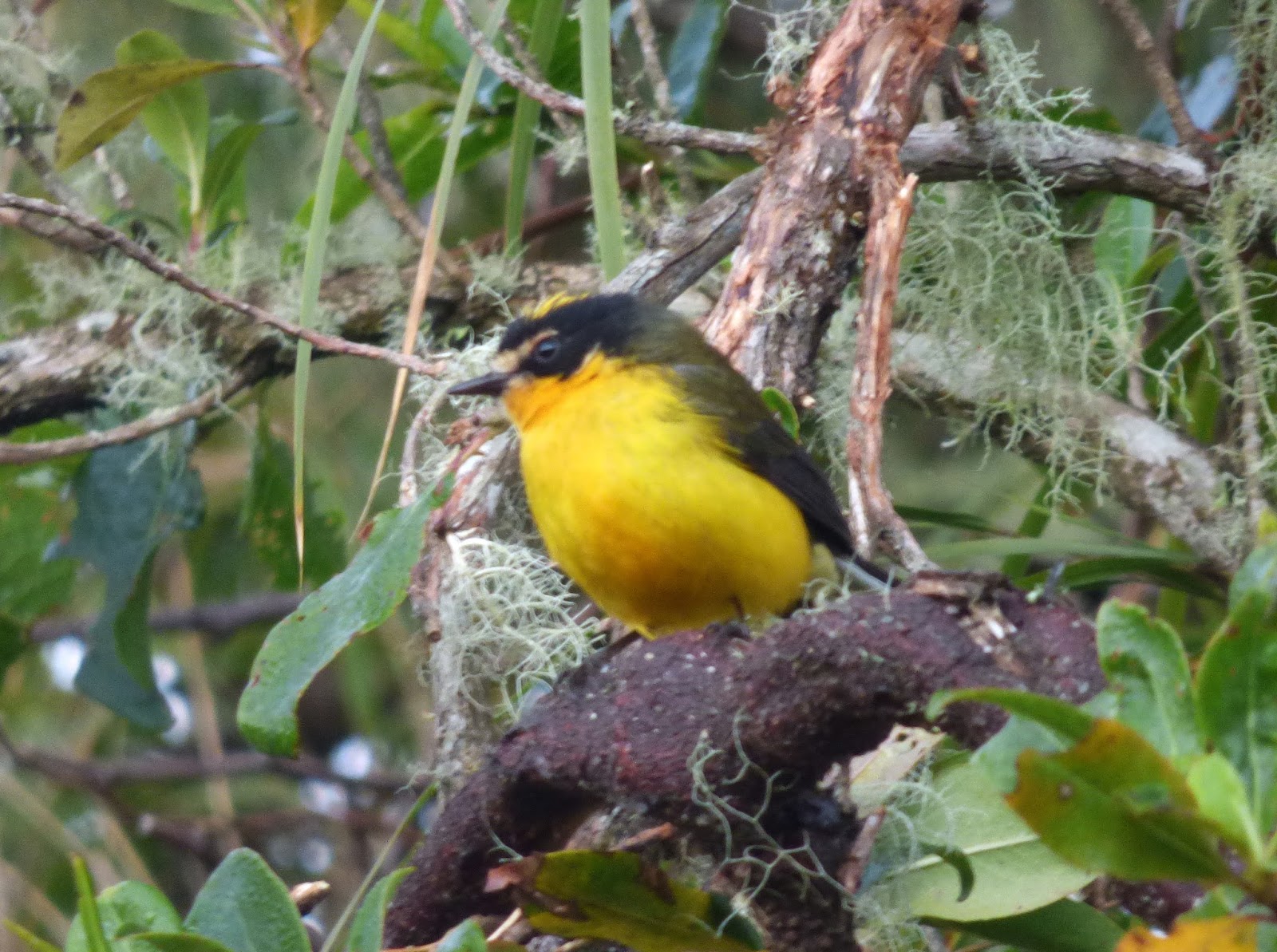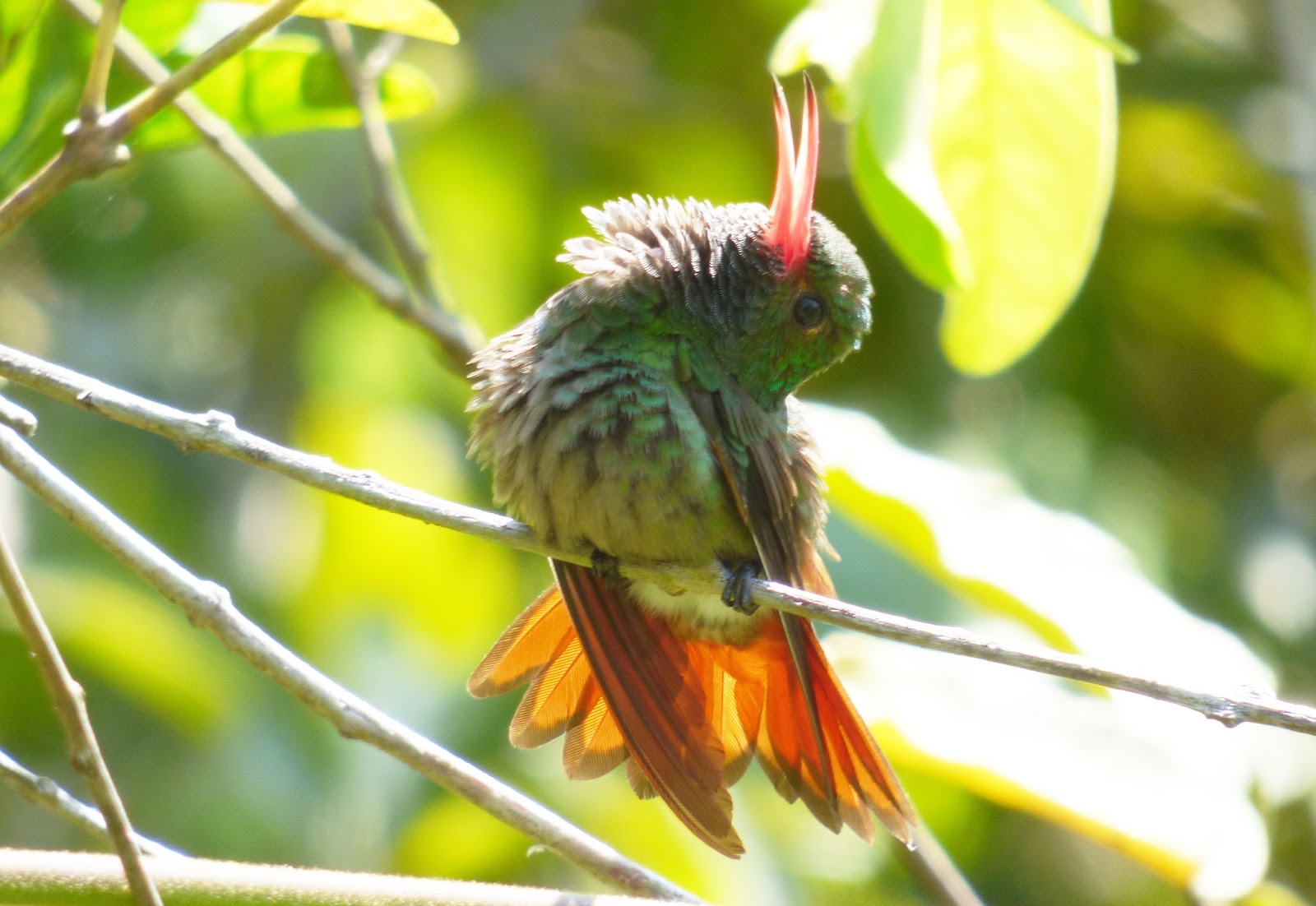Twelve brave souls ventured out of the Carolinas and across
the Caribbean Sea to embark on a week-long birding tour of Colombia’s northern
coast led by conservation biologist, Natalia Ocampo-Penuela and Carolina
Birder, Scott Winton (the author). We
collectively observed more than 285 species including about 30 endemics or
near-endemics and more than 40 neotropical migrants. Lifers were added constantly and some
participants saw more than 200 new birds!
Our trip started and ended at the beautiful , historic city
of Cartagena, a UNESCO world heritage site.
While the birdlife here is outshone by the city’s ramparts and colonial
architecture, the Magnificent Frigatebirds and Brown-throated Parakeets
ever-present overhead set the tropical tone.
 |
| Brown-throated Parakeet, common along the Caribbean coast |
The first major birding stop was made for a boat ride
through the mangroves of Salamanca National Park. While being poled through creeks and pools we
spotted a Bare-throated Tiger-Heron, American Pygmy Kingfishers, Golden-green
Woodpecker, and the mangrove specialist, near-threatened Bicolored
Conebill.
| Boat Ride at Salamanca National Park |
After a night in Santa Marta we headed up the side of the
Sierra Nevada toward El Dorado, a lodge and reserve set high in the cloud
forest. The road up the mountain was very
rough, but lead us to exciting and easy birding right from the lodge. The
hummingbird and banana feeders were abuzz with Green Violetears, Purple-crowned
Woodnymphs, Blue-naped Chlorophonias and Black-capped Tanagers.
 |
| Violet-crowned Woodnymph, El Dorado |
 |
| Blue-naped Chlorophonia, El Dorado |
Occasional visits by the endemic White-tailed
Starfrontlet and endemic Black-backed Thornbill were thrilling.
 |
| Black-backed Thornbill (with Violet-Crowned Woodnymphs), El Dorado |
The lodge’s compost pile attracted both
endemic Brush-Finch species (Santa Marta and Sierra Nevada)...
 |
| Santa Marta Brush-Finch, El Dorado |
 |
| Sierra Nevada Brush-Finch, El Dorado |
...and a flock of 13
of the endemic Black-fronted Wood-Quail.
 |
| Black-faced Wood-Quail, El Dorado |
The yet-to-be-described Santa Marta Screech-Owl could be viewed roosting
two minutes away from the dining room.
 |
| Santa Marta Screech-Owl, El Dorado |
Our first morning at El Dorado we set off an hour before
dawn along another very bumpy road to 2500 meters elevation. We were rewarded immediately by endemic Santa
Marta Parakeets at dawn, endemic Yellow-crowned Whitestarts singing away...
 |
| Yellow-crowned Whitestart, El Dorado |
...and
spectacular views and even photos of the elusive, difficult endemic Santa Marta
Warbler, a frequently missed species.
 |
| Santa Marta Warbler, El Dorado |
We
also enjoyed scope views of the endemic Santa Marta Toucanet...
 |
| Santa Marta Emerald Toucanet, El Dorado |
...and the endemic
White-tipped Quetzal, which was for many the bird of the trip.
 |
| White-tipped Quetzal, El Dorado |
After ticking a couple endemic spinetails, Buff-breasted and
Santa Marta Mountain-Tanagers, and failing to scare a Rufous Antpitta or
Brown-rumped Tapaculo into view, we made our way back downslope during the
afternoon lull.
Our knowledgeable local guide, Lorenzo, had us stop midway at a spot known for having Golden-breasted Fruiteater. We heard it calling quickly enough, but then it went silent and I could see that Lorenzo was worried. The looming figure of a Black-and-Chestnut Eagle (listed as Vulnerable by the IUCN) swooping overhead proved to be the issue! After some patience the fruiteater began to vocalize again and somehow I caught a glimpse of it as it landed in the canopy where it cooperatively sat for 15 minutes so all could view it in the scope. Lorenzo said that many birders leave thinking they’ve seen the fruiteater when they were just looking at a leaf—not us!
That evening we enjoyed spectacular views of several Band-tailed and Sickle-winged Guans feeding on flower buds in some trees hanging over deck outside the lodge dinning room.
Our knowledgeable local guide, Lorenzo, had us stop midway at a spot known for having Golden-breasted Fruiteater. We heard it calling quickly enough, but then it went silent and I could see that Lorenzo was worried. The looming figure of a Black-and-Chestnut Eagle (listed as Vulnerable by the IUCN) swooping overhead proved to be the issue! After some patience the fruiteater began to vocalize again and somehow I caught a glimpse of it as it landed in the canopy where it cooperatively sat for 15 minutes so all could view it in the scope. Lorenzo said that many birders leave thinking they’ve seen the fruiteater when they were just looking at a leaf—not us!
That evening we enjoyed spectacular views of several Band-tailed and Sickle-winged Guans feeding on flower buds in some trees hanging over deck outside the lodge dinning room.
 |
| Band-tailed Guan, El Dorado |
As anticipated, the birds at El Dorado were the trip
highlights, not to mention the views of the Caribbean Sea in one direction and
Colombia’s highest snow-capped peaks in the other.
| view of the Caribbean Sea and Cienega Grande from El Dorado |
I think we all wanted to stay and bird the reserve more, but after two nights it was time to bump our way back downhill. Birding stops on the trip down yielded Barred Forest-Falcon, Keel-billed Toucan, fantastic views of the Santa Marta subspecies of Red-billed Parrot, a Mourning Warbler, and the endemic Santa Marta Antbird.
 |
| Santa Marta Red-billed Parrot, Bolivar |
We stayed a night in the foothill town of Minca at a hotel by the same name. Its hummingbird feeders hosted a new array of species, such as Rufous-tailed Hummingbird...
 |
| Rufous-tailed Hummingbird, Minca |
 |
| Steely-vented Hummingbird, Minca |
The next morning we birded the road up from Minca, with some
of the crowd favorites being Golden-winged Sparrow, Swallow Tanager, Scaled
Piculet and White-bearded Manakin.
 |
| Golden-winged Sparrow, Bolivar |
After
lunch we said goodbye to Lorenzo who had been our faithful guide for three days
and resumed our journey northward along the coast.
After rough roads and cold early mornings up in the Sierra
Nevada, the idyllic beachfront splendor of El Matuy resort is just what the
group needed. While the setting demanded
relaxation, that didn’t stop us from birding!
It was well worth the early wake-up in order to get to our desert
birding spot early. We immediately found
one of the key targets here in a very cooperative male Vermillion Cardinal. Other exciting finds were Caribbean
Pale-legged Hornero, White-whiskered Spinetail, Orinocan
Saltator, Chestnut Piculet...
 |
| Chestnut Piculet, Guajira |
...and Black-crested Antshrike.
 |
| Black-crested Antshrike, Guajira |
By the time we got to the lagoon at Los Flamencos it was midday
and blazing hot with the namesake flamingoes nowhere in sight. We decided taking a boat out under the sun
for two hours would be a bad idea. The
flamingos were not worth heat stroke and we had already seen three in a
roadside pond anyway.
 |
| American Flamingos in a roadside pond near Cartagena |
While scoping the lagoon from shore I noticed a
black-backed, white-headed gull looming over a large flock of Royal, Common and
Sandwich Terns. I told the group it was
a Great Black-backed Gull, but later realized I had been looking at a Belcher’s
Gull, not quite as rare a bird for Colombia, but way out of range on the
Caribbean Coast. This was probably the
most unusual bird we observed on the trip and I managed to misidentify it—a classic
gringo mistake!
The evening after Los Flamencos I came down with a nasty stomach
bug that put me out of commission for the next 24 hours. I expected somebody to get sick on the trip I
just didn’t think it would be me! I
think I may have had better birding luck sitting at the van than walking the
road on our final morning, picking up a flyover Pearl Kite and a couple
Golden-fronted Greenlets. Fortunately
one of the latter stuck around for the group to see when they returned.
 |
| Golden-fronted Greenlet, Bolivar |
In an effort to spend down our budget surplus we dined at
the fanciest of Cartagena’s restaurants, Don Juan, for our final trip dinner.
While we couldn’t manage to break the bank (even the best food in Cartagena is
reasonably priced) it was an excellent spot to celebrate all the lifers and reminisce
over a fantastic week of birding.
| The Group |

















